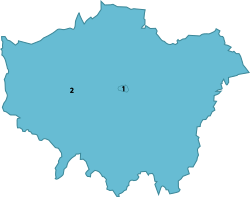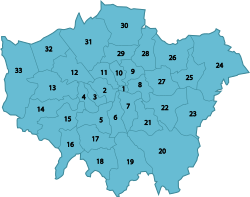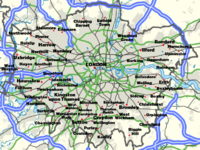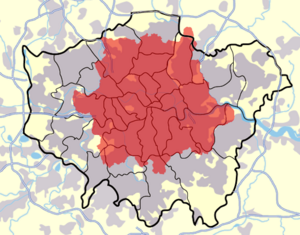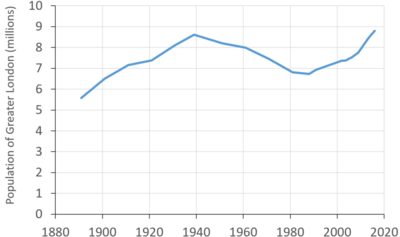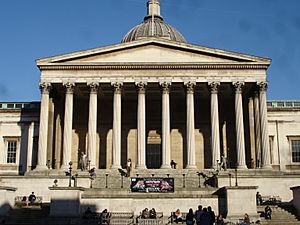Greater London facts for kids
Quick facts for kids
Greater London
and London (region)
|
|||||||||||||||||||||||||||||||||||||||||||||||||
|---|---|---|---|---|---|---|---|---|---|---|---|---|---|---|---|---|---|---|---|---|---|---|---|---|---|---|---|---|---|---|---|---|---|---|---|---|---|---|---|---|---|---|---|---|---|---|---|---|---|
|
Ceremonial county and region
|
|||||||||||||||||||||||||||||||||||||||||||||||||
|
The City of London; City Hall in Newham, the headquarters of the Greater London Authority; and Hampstead Heath
|
|||||||||||||||||||||||||||||||||||||||||||||||||
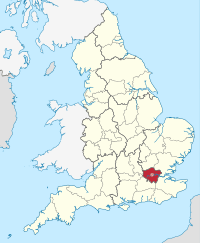
Greater London ceremonial county (red)
City of London (red & white stripes) Greater London administrative area (London Region) (both) |
|||||||||||||||||||||||||||||||||||||||||||||||||
| Sovereign state | United Kingdom | ||||||||||||||||||||||||||||||||||||||||||||||||
| Constituent country | England | ||||||||||||||||||||||||||||||||||||||||||||||||
| Established | 1 April 1965 | ||||||||||||||||||||||||||||||||||||||||||||||||
| Established by | London Government Act 1963 | ||||||||||||||||||||||||||||||||||||||||||||||||
| Time zone | UTC±00:00 (Greenwich Mean Time) | ||||||||||||||||||||||||||||||||||||||||||||||||
| • Summer (DST) | UTC+01:00 (British Summer Time) | ||||||||||||||||||||||||||||||||||||||||||||||||
| Members of Parliament | 73 MPs | ||||||||||||||||||||||||||||||||||||||||||||||||
| Police | |||||||||||||||||||||||||||||||||||||||||||||||||
|
|||||||||||||||||||||||||||||||||||||||||||||||||
Greater London is the official name for the area that makes up London, England. It's like the big region that includes the famous City of London and 32 other areas called London boroughs.
This large area is managed by the Greater London Authority. This group helps run things for the whole region. Each borough also has its own local council. Greater London is surrounded by other counties like Hertfordshire, Essex, Kent, Surrey, Berkshire, and Buckinghamshire.
Greater London covers about 1,572 square kilometers (about 607 square miles). In 2022, around 8.8 million people lived here. Most of this area is urban, meaning it's built up with homes and businesses. Even though it's a huge area, Greater London itself doesn't have "city status." However, two smaller parts within it, the City of London and the City of Westminster, do have this special status. Historically, this area was part of several different counties.
The River Thames is a very important river that flows through London. It enters near Hampton in the west and flows east, leaving near Dagenham. Many smaller rivers, called tributaries, also flow into the Thames. Most of these are now underground as part of London's sewer system. The land near the river is flat, but it rises to small hills like Hampstead Heath and Sydenham Hill. The highest point in Greater London is Westerham Heights, which is 245 meters (804 feet) high. In the northeast, you can find part of Epping Forest, an old woodland.
The City of London has had its own government for a very long time, since Anglo-Saxon times. The first government that covered all of London was the London County Council, started in 1889. In 1965, this council was replaced by Greater London. This new area was governed by the Greater London Council, the 32 London boroughs, and the City of London Corporation. The Greater London Council was later removed in 1986. Its jobs were then taken over by the boroughs. The Greater London Authority was then created in 2000.
Contents
How London's Government Changed
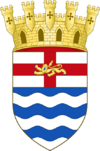
The name "Greater London" was used even before it became official in 1965. It referred to areas covered by the police, water board, and transport system. It was also used for road plans and a planning region.
Plans to Make London Bigger
Even though the London County Council (LCC) was set up in 1889, it didn't cover all of London. Many parts of London, like its built-up areas and postal service, were much larger than the LCC's boundaries. The LCC wanted to expand its area after the First World War. A special group was formed in 1923 to look into this. The LCC suggested a much larger Greater London. However, this idea was rejected.
Later, another group called the Royal Commission on Local Government in Greater London studied the issue. They looked at how connected different communities were to London. Their report in 1960 helped shape the future of London's government.
When Greater London Was Created
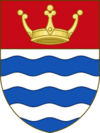
Greater London was officially created on April 1, 1965, by a law called the London Government Act 1963. This new area replaced the old counties of Middlesex and London. It also took in parts of Essex, Hertfordshire, Kent, and Surrey.
At first, Greater London had two levels of government: the Greater London Council (GLC) and the 32 London Borough councils, plus the City of London Corporation. The GLC was later removed in 1986. Its jobs were then given to the City Corporation and the London Boroughs. Greater London became the official London region in 1994.
The Greater London Authority

In 1998, people voted to bring back a main government for the region. This led to the creation of the Greater London Authority (GLA) in 2000. The GLA includes the London Assembly and a directly elected Mayor of London.
The Mayor of London is like the chief executive for the whole region. The current Mayor is Sadiq Khan. The London Assembly checks the Mayor's work and can make changes to the budget. The GLA's main office is now at The Crystal in Newham. The Mayor is in charge of planning for Greater London's future.
London's Geography
Greater London includes the main built-up areas of London and some green spaces. It has parts of the Metropolitan Green Belt, which protects natural land. Greater London borders Hertfordshire to the north, Berkshire and Buckinghamshire to the west, Kent to the southeast, and Surrey to the south.
The highest point in Greater London is Westerham Heights, which is 245 meters (804 feet) high. It's located on the border with Kent. There have been a few small changes to London's boundaries over time. For example, some areas were moved to Surrey and Kent in 1969. Most of Greater London is covered by the Low Emission Zone (LEZ) and the Ultra Low Emission Zone (ULEZ), which aim to reduce pollution from vehicles.
It's important to know that the London postal district does not cover all of Greater London.
How London is Governed
Greater London is managed by the Greater London Authority (GLA). This authority has an elected group called the London Assembly and a leader called the Mayor of London.
The Mayor of London is elected by the people. The current Mayor is Sadiq Khan. The London Assembly checks what the Mayor does. The GLA's main office is in Newham. The Mayor is responsible for planning how Greater London will grow and change.
The Mayor of London
The Mayor of London is a politician chosen directly by the people. Along with the London Assembly, the Mayor is in charge of running Greater London.
The London Assembly
For elections to the London Assembly, London is divided into 14 areas. Each area is made up of two or three boroughs. The City of London is part of the City and East area.
UK Parliament
London is divided into 73 areas for the UK Parliament. These areas are made up of smaller sections from one or more boroughs. Usually, a borough is covered by two or three of these areas.
London's Special Status
The London Region itself does not have "city status" from the Queen. However, the Cities of London and Westminster within it do. Even so, Greater London is often seen as a city because it's a huge urban area. A special person called the Lord Lieutenant of Greater London is appointed for this area, except for the City of London.
The word "London" usually means the whole Greater London area, not just the tiny, old City of London. That small area is often called "the City" or "the Square Mile" and is the main financial center. In everyday talk, "London" and "Greater London" mean the same thing. Greater London is also divided into Inner London and Outer London for some purposes.
Local Government in London
Greater London is split into 32 London boroughs. Each borough has its own council. The City of London has a very old and unique government that dates back to the 12th century. It's separate from the county of Greater London, but it's still part of the region that the Greater London Authority serves.
All the London Borough councils are part of the London Councils association. Three London Boroughs have the special title of Royal Borough: Kensington and Chelsea, Kingston, and Greenwich.
London's People and Population
London's population grew very quickly in the 1800s and early 1900s. It was the most populated city in the world until 1925. Its population reached its highest point in 1939 with over 8.6 million people. It then went down to 6.7 million in 1988 before starting to grow again.
By 2006, the population was back to what it was in the 1970s. It has now gone over the 1939 peak and is more than 9 million. London is one of the world's largest cities and metropolitan areas. It also has many very wealthy people living there. London is known as one of the most expensive cities in the world.
Different Ethnic Groups in London
London is a very diverse city with people from all over the world. In the 2021 UK Census, about 53.8% of people identified as White. About 20.7% were Asian, and 13.5% were Black. There were also people of mixed race and other ethnic groups.
A survey in 2005 found that over 300 languages are spoken in London. There are also more than 50 communities with over 10,000 people who were not originally from the UK. In 2006, about 31% of London's population was born outside the UK.
London has always been a place where people come to live, either for safety or for better jobs. Groups like Huguenots, Eastern European Jews, and people from the Caribbean have made London their home. The East End of London, especially around Spitalfields, has often been the first home for many new groups of people.
| Ethnic group | 2001 | 2011 | 2021 | |||
|---|---|---|---|---|---|---|
| Number | % | Number | % | Number | % | |
| White: British | 4,287,861 | 59.79% | 3,669,284 | 44.89% | 3,239,281 | 36.81% |
| White: Irish | 220,488 | 3.07% | 175,974 | 2.15% | 156,333 | 1.78% |
| White: Gypsy or Irish Traveller | N/A | 8,196 | 0.10% | 7,031 | 0.08% | |
| White: Roma | N/A | 37,689 | 0.43% | |||
| White: Other | 594,854 | 8.29% | 1,033,981 | 12.65% | 1,290,838 | 14.67% |
| White: subtotal | 5,103,203 | 71.15% | 4,887,435 | 59.79% | 4,731,172 | 53.76% |
| Asian or Asian British: Indian | 436,993 | 6.09% | 542,857 | 6.64% | 656,272 | 7.46% |
| Asian or Asian British: Pakistani | 142,749 | 1.99% | 223,797 | 2.74% | 290,549 | 3.30% |
| Asian or Asian British: Bangladeshi | 153,893 | 2.15% | 222,127 | 2.72% | 322,054 | 3.66% |
| Asian or Asian British: Chinese | 80,201 | 1.12% | 124,250 | 1.52% | 147,520 | 1.68% |
| Asian or Asian British: Other Asian | 133,058 | 1.86% | 398,515 | 4.88% | 401,245 | 4.56% |
| Asian or Asian British: subtotal | 946,894 | 13.20% | 1,511,546 | 18.49% | 1,817,640 | 20.66% |
| Black or Black British: African | 378,933 | 5.28% | 573,931 | 7.02% | 697,054 | 7.92% |
| Black or Black British: Caribbean | 343,567 | 4.79% | 344,597 | 4.22% | 345,405 | 3.93% |
| Black or Black British: Other Black | 60,349 | 0.84% | 170,112 | 2.08% | 145,911 | 1.66% |
| Black or Black British: subtotal | 782,849 | 10.92% | 1,088,640 | 13.32% | 1,188,370 | 13.50% |
| Mixed: White and Black Caribbean | 70,928 | 0.99% | 119,425 | 1.46% | 132,555 | 1.51% |
| Mixed: White and Black African | 34,182 | 0.48% | 65,479 | 0.80% | 77,341 | 0.88% |
| Mixed: White and Asian | 59,944 | 0.84% | 101,500 | 1.24% | 125,188 | 1.42% |
| Mixed: Other Mixed | 61,057 | 0.85% | 118,875 | 1.45% | 170,691 | 1.94% |
| Mixed: subtotal | 226,111 | 3.15% | 405,279 | 4.96% | 505,775 | 5.75% |
| Other: Arab | N/A | 106,020 | 1.30% | 139,791 | 1.59% | |
| Other: Any other ethnic group | 113,034 | 1.58% | 175,021 | 2.14% | 416,977 | 4.74% |
| Other: subtotal | 113,034 | 1.58% | 281,041 | 3.44% | 556,768 | 6.33% |
| Total | 7,172,091 | 100.00% | 8,173,941 | 100.00% | 8,799,725 | 100.00% |
London's Population Growth Over Time
The population of Greater London has changed a lot over the years. In 1801, about 1.1 million people lived in the area. This number grew to an estimated 8.6 million in 1939. However, it then dropped to 6.7 million in 1988 before starting to increase again in the 1990s.
By 2006, the population had reached the same level as in the 1970s. It has now gone past the previous high point of 1939 and is over 9 million.
| 1891 | 5–6 April | 5,572,012 |
| 1901 | 31 March – 1 April | 6,506,954 |
| 1911 | 2–3 April | 7,160,525 |
| 1921 | 19–20 June | 7,386,848 |
| 1931 | 26–27 April | 8,110,480 |
| 1939 | Mid-year estimate | 8,615,245 |
| 1951 | 8–9 April | 8,196,978 |
| 1961 | 23–24 April | 7,992,616 |
| 1965 | Greater London formally created | |
| 1971 | 25–26 April | 7,452,520 |
| 1981 | Mid-year estimate | 6,805,000 |
| 1988 | Mid-year estimate | 6,729,300 |
| 1991 | Mid-year estimate | 6,829,300 |
| 2001 | Mid-year estimate | 7,322,400 |
| 2002 | Mid-year estimate | 7,361,600 |
| 2003 | Mid-year estimate | 7,364,100 |
| 2004 | Mid-year estimate | 7,389,100 |
| 2005 | Mid-year estimate | 7,456,100 |
| 2006 | Mid-year estimate | 7,512,400 |
| 2009 | Mid-year estimate | 7,753,600 |
| 2013 | Mid-year estimate | 8,416,535 |
| 2014 | Mid-year estimate | 8,546,761 |
| 2016 | Mid-year estimate | 8,798,957 |
London's Economy
London is a very important economic center. Many businesses and financial services are based here. It is one of the world's leading cities for business and finance.
Religion in London
London is home to people of many different religions. The largest group is Christian (48.4%). There are also many Muslims (8.4%), Hindus (8.0%), Jews (1.8%), Sikhs (1.5%), and Buddhists (1.0%). About 21.7% of people say they have no religion.
The United Kingdom has traditionally been Christian, and London has many churches. St Paul's Cathedral and Southwark Cathedral are important Anglican churches. The leader of the Church of England, the Archbishop of Canterbury, lives at Lambeth Palace in London. Important national events often take place at St Paul's and Westminster Abbey. Westminster Cathedral is the largest Roman Catholic cathedral in England and Wales.
London also has large Hindu, Sikh, Buddhist, Muslim, and Jewish communities. Many Muslims live in Tower Hamlets and Newham. Important Muslim buildings include the East London Mosque and the London Central Mosque. London's large Hindu community is mainly in the northwest, with one of Europe's largest Hindu temples, BAPS Shri Swaminarayan Mandir London, located in Brent.
Sikh communities are found in East and West London, especially in Southall, which has the largest Sikh temple in the capital. Most British Jews live in London, with big communities in Stamford Hill and North London areas like Golders Green.
Education in London
Public schools in London are managed by 33 local education authorities. These are the City of London and the 32 London boroughs. From 1965 to 1990, 12 Inner London boroughs and the City of London were managed by the Inner London Education Authority.
Most schools in Greater London are "comprehensive schools," which means they teach students of all abilities. However, 19 "grammar schools" (which select students based on academic ability) are still in some Outer London boroughs. In these boroughs, state schools often perform better than private schools. In Inner London, private schools usually get the best results.
For exams like GCSE and A level, Outer London boroughs generally have better results than Inner London boroughs. Kingston upon Thames and Sutton often have some of the best GCSE results in England. Overall, Greater London has some of the best GCSE results among regions in England.
Universities in London
London is home to many famous universities. The University of London is a large group of 20 colleges and schools. Some of its main parts are University College London (UCL) and King's College London (KCL). Imperial College used to be part of the University of London but is now an independent university. UCL, KCL, and Imperial receive a lot of money for research.
Other important universities include Queen Mary University of London and City, University of London. London also has the London School of Economics and Political Science (LSE), which focuses on social sciences. These universities attract many students from all over the UK and the world.
Many students who graduate from the University of London choose to stay and work in London.
Sister Cities
The Greater London Authority has special agreements with other cities around the world. These are called twin or sister city agreements, and they help London connect with other major cities globally.
| Country | City | Region | Year | |
|---|---|---|---|---|
| China | Shanghai | Shanghai Municipality | 2009 | |
| China | Beijing | Beijing Municipality | 2006 | |
| France | Paris | Île-de-France | 2001 | |
| Germany | Berlin | Berlin | 2000 | |
| Russia | Moscow | Russian federal city | 2002 | |
| United States | New York City | New York | 2001 | |
| Japan | Tokyo | Tokyo | 2005 | |
| Croatia | Zagreb | City of Zagreb | 2009 | |
| India | Mumbai | Maharashtra | ||
Images for kids
-
Arms of the former London County Council
-
Arms of the former Greater London Council
-
Logo of the Greater London Authority
-
Westminster Abbey. A World Heritage Site and where British monarchs are crowned.
-
University College London, a main part of the University of London
See also
 In Spanish: Gran Londres para niños
In Spanish: Gran Londres para niños
- Geographical
- Central London
- Inner London
- Outer London
- London boroughs
- Greater London Urban Area
- London commuter belt
- Metropolitan Police District
- M25 motorway
- Political
- Mayor of London
- List of Lord Lieutenants of Greater London
- List of High Sheriffs of Greater London
- London Plan
- City of London
- Historical
- Others





